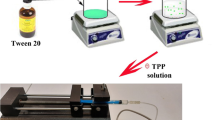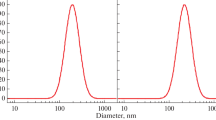Abstract
The development of new green drugs is crucial because of the side effects and resistance to chemotropic drugs. Essential oils with a broad range of bioactivities such as antioxidant and anticancer activities are great resources for research and investigation. In this study, ingredients of the used Syzygium aromaticum essential oil (SAEO) were identified using gas chromatography-mass spectrometry (GC-MS) analysis. The antioxidant effect of eugenol (major ingredients) was more potent than SAEO; their half-maximal inhibitory concentrations (IC50s) were observed at 109 and 204 μg mL−1. Chitosan nanoparticles containing SAEO (158 ± 4 nm) and eugenol (200 ± 13 nm) were prepared using the ionic gelation method. The potency of the nanoformulations was significantly more than their non-formulated states on both examined cell lines. IC50s of chitosan nanoparticles containing SAEO and eugenol against melanoma (A-375) cells were obtained at 73 and 79 μg mL−1; these values on breast (MDA-MB-468) cells were 177 and 51 μg mL−1. Results showed that chitosan nanoparticles containing eugenol could be considered chemo-preventative or anticancer agents in further in vivo studies.






Similar content being viewed by others
Availability of Data and Material
Ok.
Code Availability
Not applicable.
References
Miller, K. D., Fidler-Benaoudia, M., Keegan, T. H., Hipp, H. S., Jemal, A., & Siegel, R. L. (2020). Cancer statistics for adolescents and young adults, 2020 CA. Cancer Journal for Clinicians, 70(6), 443–459. https://doi.org/10.3322/caac.21637.
Hayes, J. D., Dinkova-Kostova, A. T., & Tew, K. D. (2020). Oxidative stress in cancer. Cancer Cell, 38(2), 167–197. https://doi.org/10.1016/j.ccell.2020.06.001.
Breast cancer: prevention and control. (2019) World Health Organization. https://www.who.int/cancer/detection/breastcancer/en/. Accessed September
González-Jiménez, E., García, P. A., Aguilar, M. J., Padilla, C. A., & Álvarez, J. (2014). Breastfeeding and the prevention of breast cancer: A retrospective review of clinical histories. Journal of Clinical Nursing, 23(17-18), 2397–2403. https://doi.org/10.1111/jocn.12368.
Comşa, Ş., Cimpean, A. M., & Raica, M. (2015). The story of MCF-7 breast cancer cell line: 40 years of experience in research. Anticancer Research, 35(6), 3147–3154.
Jänicke, R. U. (2009). MCF-7 breast carcinoma cells do not express caspase-3. Breast Cancer Res. Treat., 117(1), 219–221. https://doi.org/10.1007/s10549-008-0217-9.
Ossio, R., Roldan-Marin, R., Martinez-Said, H., Adams, D. J., & Robles-Espinoza, C. D. (2017). Melanoma: A global perspective. Nature Reviews Cancer, 17(7), 393–394. https://doi.org/10.1038/nrc.2017.43.
Leonardi, G. C., Falzone, L., Salemi, R., Zanghì, A., Spandidos, D. A., Mccubrey, J. A., Candido, S., & Libra, M. (2018). Cutaneous melanoma: From pathogenesis to therapy. International Journal of Oncology, 52(4), 1071–1080. https://doi.org/10.3892/ijo.2018.4287.
Khorsandi, K., Hosseinzadeh, R., & Chamani, E. (2020). Molecular interaction and cellular studies on combination photodynamic therapy with rutoside for melanoma A375 cancer cells: An in vitro study. Cancer Cell International, 20(1), 1–15. https://doi.org/10.1186/s12935-020-01616-x.
Moreb, J., & Zucali, J. R. (1992). The therapeutic potential of interleukin-1 and tumor necrosis factor on hematopoietic stem cells. Leukemia and Lymphoma, 8(4-5), 267–275. https://doi.org/10.3109/10428199209051006.
Pirmoradian, M., Budamgunta, H., Chingin, K., Zhang, B., Astorga-Wells, J., & Zubarev, R. A. (2013). Rapid and deep human proteome analysis by single-dimension shotgun proteomics. Molecular and Cellular Proteomics, 12(11), 3330–3338. https://doi.org/10.1074/mcp.O113.028787.
Maksimović-Ivanić, D., Bulatović, M., Edeler, D., Bensing, C., Golić, I., Korać, A., Kaluđerović, G. N., & Mijatović, S. (2019). The interaction between sba-15 derivative loaded with Ph 3 Sn (Ch 2) 6 Oh and human melanoma A375 cell line: Uptake and stem phenotype loss. Journal of Biological Inorganic Chemistry, 24(2), 223–234.
Olaku, O., & White, J. D. (2011). Herbal therapy use by cancer patients: A literature review on case reports. European Journal of Cancer, 47(4), 508–514. https://doi.org/10.1016/j.ejca.2010.11.018.
Shen, J., Andersen, R., Albert, P. S., Wenger, N., Glaspy, J., Cole, M., & Shekelle, P. (2002). Use of complementary/alternative therapies by women with advanced-stage breast cancer. BMC Complement. Altern. Med, 2(1), 8. https://doi.org/10.1186/1472-6882-2-8.
Blowman, K., Magalhães, M., Lemos, M., Cabral, C., & Pires, I. (2018). Anticancer properties of essential oils and other natural products. Evidence-based Complementary and Alternative Medicine, 2018, 3149362. https://doi.org/10.1155/2018/3149362.
Osanloo, M., Sedaghat, M. M., Esmaeili, F., & Amani, A. (2018). Larvicidal activity of essential oil of Syzygium aromaticum (clove) in comparison with its major constituent, eugenol, against Anopheles stephensi. Journal of Arthropod-Borne Diseases, 12(4), 361–369. https://doi.org/10.18502/jad.v12i4.354.
Gülçin, İ., Elmastaş, M., & Aboul-Enein, H. Y. (2012). Antioxidant activity of clove oil–A powerful antioxidant source. Arabian Journal of Chemistry, 5(4), 489–499. https://doi.org/10.1016/j.arabjc.2010.09.016.
Nirmala, M. J., Durai, L., Gopakumar, V., & Nagarajan, R. (2019). Anticancer and antibacterial effects of a clove bud essential oil-based nanoscale emulsion system. International Journal of Nanomedicine, 14, 6439. https://doi.org/10.2147/IJN.S211047.
Qian, W., Sun, Z., Wang, T., Yang, M., Liu, M., Zhang, J., & Li, Y. (2020). Antimicrobial activity of eugenol against carbapenem-resistant Klebsiella pneumoniae and its effect on biofilms. Microbial Pathogenesis, 139, 103924. https://doi.org/10.1016/j.micpath.2019.103924.
Li, Z., Veeraraghavan, V. P., Mohan, S. K., Bolla, S. R., Lakshmanan, H., Kumaran, S., Aruni, W., Aladresi, A. A. M., Shair, O. H. M., Alharbi, S. A., & Chinnathambi, A. (2020). Apoptotic induction and anti-metastatic activity of eugenol encapsulated chitosan nanopolymer on rat glioma C6 cells via alleviating the MMP signaling pathway. Journal of Photochemistry and Photobiology B: Biology, 203, 111773. https://doi.org/10.1016/j.jphotobiol.2019.111773.
Jaganathan, S. K., Mazumdar, A., Mondhe, D., & Mandal, M. (2011). Apoptotic effect of eugenol in human colon cancer cell lines. Cell Biology International, 35(6), 607–615. https://doi.org/10.1042/cbi20100118.
Slameňová, D., Horváthová, E., Wsólová, L., Šramková, M., & Navarová, J. (2009). Investigation of anti-oxidative, cytotoxic, DNA-damaging and DNA-protective effects of plant volatiles eugenol and borneol in human-derived HepG2, Caco-2 and VH10 cell lines. Mutation Research, Genetic Toxicology and Environmental Mutagenesis, 677(1-2), 46–52. https://doi.org/10.1016/j.mrgentox.2009.05.016.
Adir, O., Poley, M., Chen, G., Froim, S., Krinsky, N., Shklover, J., Shainsky-Roitman, J., Lammers, T., & Schroeder, A. (2020). Integrating artificial intelligence and nanotechnology for precision cancer medicine. Advanced Materials, 32(13), 1901989. https://doi.org/10.1002/adma.201901989.
Coimbra, M., Isacchi, B., van Bloois, L., Torano, J. S., Ket, A., Wu, X., Broere, F., Metselaar, J. M., Rijcken, C. J., & Storm, G. (2011). Improving solubility and chemical stability of natural compounds for medicinal use by incorporation into liposomes. International Journal of Pharmaceutics, 416(2), 433–442. https://doi.org/10.1016/j.ijpharm.2011.01.056.
Wang, W., Meng, Q., Li, Q., Liu, J., Zhou, M., Jin, Z., & Zhao, K. (2020). Chitosan derivatives and their application in biomedicine. International Journal of Molecular Sciences, 21(2), 487. https://doi.org/10.3390/ijms21020487.
Zhang, H., Huang, X., Sun, Y., Xing, J., Yamamoto, A., & Gao, Y. (2016). Absorption-improving effects of chitosan oligomers based on their mucoadhesive properties: A comparative study on the oral and pulmonary delivery of calcitonin. Drug Delivery, 23(7), 2419–2427. https://doi.org/10.3109/10717544.2014.1002946.
Sohail, R., & Abbas, S. R. (2020). Evaluation of amygdalin-loaded alginate-chitosan nanoparticles as biocompatible drug delivery carriers for anticancerous efficacy. International Journal of Biological Macromolecules, 153, 36–45. https://doi.org/10.1016/j.ijbiomac.2020.02.191.
Mazzotta, E., De Benedittis, S., Qualtieri, A., & Muzzalupo, R. (2020). Actively targeted and redox responsive delivery of anticancer drug by chitosan nanoparticles. Pharmaceutics, 12(1), 26. https://doi.org/10.3390/pharmaceutics12010026.
Moemenbellah-Fard, M. D., Abdollahi, A., Ghanbariasad, A., & Osanloo, M. (2020). Antibacterial and leishmanicidal activities of Syzygium aromaticum essential oil versus its major ingredient, eugenol. Flavour and Fragrance Journal, 35(5), 534–540. https://doi.org/10.1002/ffj.3595.
Zarenezhad, E., Abdollahi, A., Esmaeili, F., Satvati, S., & Osanloo, M. (2020). A fast-degradable nano-dressing with potent antibacterial effect. BioNanoScience, 10, 983–990. https://doi.org/10.1007/s12668-020-00790-6.
Osanloo, M., Sedaghat, M., Sereshti, H., Rahmanian, M., Saeedi Landi, F., & Amani, A. (2019). Chitosan nanocapsules of tarragon essential oil with low cytotoxicity and long-lasting activity as a green nano-larvicide. Journal of Nanostructure, 9(4), 723–735. https://doi.org/10.22052/JNS.2019.04.014.
Abedinpour, N., Ghanbariasad, A., Taghinezhad, A., & Osanloo, M. (2021). Preparation of nanoemulsions of Mentha piperita essential oil and investigation of their cytotoxic effect on human breast cancer lines. BioNanoScience. https://doi.org/10.1007/s12668-021-00827-4.
Brown, N. S., & Bicknell, R. (2001). Hypoxia and oxidative stress in breast cancer oxidative stress-Its effects on the growth, metastatic potential and response to therapy of breast cancer. Breast Cancer Research, 3(5), 323–327. https://doi.org/10.1186/bcr315.
Dakah, A., Zaid, S., Suleiman, M., Abbas, S., & Wink, M. (2014). In vitro propagation of the medicinal plant Ziziphora tenuior L. and evaluation of its antioxidant activity. Saudi Journal Biological Science, 21(4), 317–323. https://doi.org/10.1016/j.sjbs.2013.12.002.
Yoo, K. M., Lee, C. H., Lee, H., Moon, B., & Lee, C. Y. (2008). Relative antioxidant and cytoprotective activities of common herbs. Food Chemistry, 106(3), 929–936. https://doi.org/10.1016/j.foodchem.2007.07.006.
Loizzo, M. R., Ben Jemia, M., Senatore, F., Bruno, M., Menichini, F., & Tundis, R. (2013). Chemistry and functional properties in prevention of neurodegenerative disorders of five Cistus species essential oils. Food and Chemical Toxicology, 59, 586–594. https://doi.org/10.1016/j.fct.2013.06.040.
Rasoanaivo, P., Fortune Randriana, R., Maggi, F., Nicoletti, M., Quassinti, L., Bramucci, M., Lupidi, G., Petrelli, D., Vitali, L. A., Papa, F., & Vittori, S. (2013). Chemical composition and biological activities of the essential oil of Athanasia brownii Hochr. (Asteraceae) endemic to Madagascar. Chemistry and Biodiversity, 10(10), 1876–1886. https://doi.org/10.1002/cbdv.201300147.
Ali, N. A., Wursterb, M., Denkert, A., Arnold, N., Fadail, I., Al-Didamony, G., Lindequist, U., Wessjohann, L., & Setzer, W. N. (2012). Chemical composition, antimicrobial, antioxidant and cytotoxic activity of essential oils of Plectranthus cylindraceus and Meriandra benghalensis from Yemen. Natural Production Communications, 7(8), 1099–1102. https://doi.org/10.1177/1934578x1200700834.
Leal, P. F., Braga, M. E., Sato, D. N., Carvalho, J. E., Marques, M. O., & Meireles, M. A. A. (2003). Functional properties of spice extracts obtained via supercritical fluid extraction. Journal of Agricultural and Food Chemistry, 51(9), 2520–2525. https://doi.org/10.1021/jf0260693.
Osanloo, M., Arish, J., & Sereshti, H. (2020). Developed methods for the preparation of electrospun nanofibers containing plant-derived oil or essential oil: A systematic review. Polymer Bulletin, 77(11), 6085–6104. https://doi.org/10.1007/s00289-019-03042-0.
Esmaili, F., Sanei-Dehkordi, A., Amoozegar, F., & Osanloo, M. (2021). A review on the use of essential oil-based nanoformulations in control of mosquitoes. Biointerface Research Applied Chemistry, 11(5), 12516–12529. https://doi.org/10.33263/BRIAC115.1251612529.
Cao, G. (2004). Nanostructures & nanomaterials: Synthesis, properties & applications. Imperial college press.
Kumari, A., Yadav, S. K., & Yadav, S. C. (2010). Biodegradable polymeric nanoparticles based drug delivery systems. Colloids and Surfaces B: Biointerfaces, 75(1), 1–18. https://doi.org/10.1016/j.colsurfb.2009.09.001.
El-Say, K. M., & El-Sawy, H. S. (2017). Polymeric nanoparticles: Promising platform for drug delivery. International Journal of Pharmaceutics, 528(1-2), 675–691. https://doi.org/10.1016/j.ijpharm.2017.06.052.
Wieczyńska, J., & Cavoski, I. (2018). Antimicrobial, antioxidant and sensory features of eugenol, carvacrol and trans-anethole in active packaging for organic ready-to-eat iceberg lettuce. Food Chemistry, 259, 251–260. https://doi.org/10.1016/j.foodchem.2018.03.137.
Fathy, M., Fawzy, M. A., Hintzsche, H., Nikaido, T., Dandekar, T., & Othman, E. M. (2019). Eugenol exerts apoptotic effect and modulates the sensitivity of HeLa cells to cisplatin and radiation. Molecules, 24(21), 3979. https://doi.org/10.3390/molecules24213979.
Funding
This study was supported by Fasa University of Medical Sciences, grant no. 97430.
Author information
Authors and Affiliations
Corresponding author
Ethics declarations
Conflict of Interest
None.
Research Involving Humans and Animals Statement
This research did not involve human and animals study.
Informed Consent
Not applicable.
Consent for Publication
Ok.
Ethics approval
This study has been ethically approved, IR.FUMS.REC.1398.139.
Additional information
Publisher’s Note
Springer Nature remains neutral with regard to jurisdictional claims in published maps and institutional affiliations.
Rights and permissions
About this article
Cite this article
Valizadeh, A., Khaleghi, A.A., Alipanah, H. et al. Anticarcinogenic Effect of Chitosan Nanoparticles Containing Syzygium aromaticum Essential Oil or Eugenol Toward Breast and Skin Cancer Cell Lines. BioNanoSci. 11, 678–686 (2021). https://doi.org/10.1007/s12668-021-00880-z
Accepted:
Published:
Issue Date:
DOI: https://doi.org/10.1007/s12668-021-00880-z




